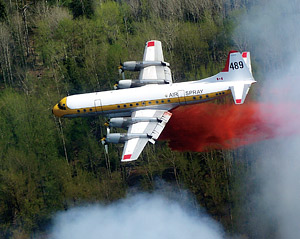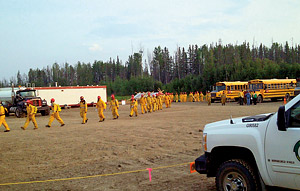|
 |
Fighting wildfires can be hot, dirty, exhausting and dangerous work done under harsh conditions in remote locations, often for many days in a row. Smoke, intense heat, falling trees and branches and terrified wildlife are just a few of the obstacles firefighting crews can face. And if conditions are correct, strong winds can increase the danger for firefighters by quickly turning a small fire into a large, dangerous blazing inferno.
In fact, some fires burn so large and intense they create their own wind and weather patterns that in turn can start more fires. This is called “thermal buoyancy”, when air around an intense fire heats up and rises while pulling in surrounding air that creates a wind pattern. This wind pattern creates hot and dry conditions that can be felt for several kilometres away.
 |
| “Fighting wildfires is dangerous work that requires the coordination of both on-the-ground and above ground fire-fighting crews.” |
Large fires also feed on themselves and even create large vortices called fire whirls that resemble tornadoes. These fire whirls have been known to throw burning debris, including logs, over great distances, spreading a wildfire much faster and farther.
Smoke from large wildfires also adds to cloud cover that can create conditions perfect for lightning strikes; the second-leading cause of forest fires everywhere.
Wildfires of a large magnitude are not only difficult to control, but can also threaten communities, such as both the Nordegg and Lodgepole fires did in May that had both communities evacuated for several days.
And everybody remembers the Slave Lake wildfire that decimated that town, burning down many homes and businesses, including the town hall, library and radio station. More than one-third of the town of 7000 people was destroyed including 374 properties.
From 2002 to 2011, Alberta averaged 1541 wildfires per year with an average of 220,874.92 hectares (about 552,000 acres) burned each year. As of May 23 of this year, Alberta has seen 476 wildfires consume 2,533.41 hectares (about 6,300 acres). With hotter summer weather still to come, along with lightning season, many more wildfires will need to be extinguished before the fire season is declared over, generally by mid-September. For those brave enough to fight wildfires, the season has just begun.
Fighting wildfires is not for the faint of heart, nor is it for the unfit. Wildland firefighters must first pass a medical screening and physical fitness test with a recommendation to “train for four to six weeks prior to attempting the fitness test.” Wildland firefighters are also tested for their fitness throughout the firefighting season.
The Type 1 training course is held each year at the Hinton Training Centre and is a very intense training program where “Instructors conduct continuous assessments of each candidate’s attitude, competence, suitability, job knowledge, ability to follow instructions and fitness.”
Some wildland firefighters are trained to battle wildfires from the air with helicopters, rappelling and parachuting crews and airtankers. These firefighters face extreme fitness and endurance tests even after completing their training in rappelling or parachuting. Pay for a wildland firefighter is $19.44 to $23.93 per hour, depending on experience.
Alberta Environment and Sustainable Resource Development (ESRD) maintain an excellent “Wildfire Status” page (http://srd.alberta.ca/Wildfire/WildfireStatus/Default.aspx) where wildfire information is provided on a regular basis. Here you can follow along with the progress of firefighting crews for each fire that is burning in the province. Included in this information is the number of on-the-ground equipment and personnel, as well as in-the-air equipment such as helicopters and airtankers. ESRD does a fantastic job in keeping up-to-date wildfire information available to the public.
 |
| Wildland firefighters arrive at camp in northern Alberta. |
As a trapper who holds a Registered Fur Management Area (RFMA), I find myself watching the Wildfire Status page daily.
At one point, in early May, a wildfire was burning precariously close to my trapline; in fact, it was on the doorstep. Using the coordinates provided by ESRD and putting them into Google Earth, I was able to determine that fire WWF-008 was way too close, and heading in my direction with the heavy east winds that were blowing. At one point, if memory serves, there were 42 firefighters, five helicopters, six bulldozers and a skidder working to control WWF-008.
I breathed a sigh of relief when after a few days of fighting this fire, it was listed as “under control” (UC). However, the next morning the fire was suddenly listed as “being held” (BH) after it regained some strength over the night. Once again, I was glued to the ESRD Wildfire Status page looking for information.
In the end, wildland firefighters stopped WWF-008 before it reached my trapline but not before it consumed more than 33 hectares of prime forest on my neighbour’s trapline.
Wildfires can cause considerable amounts of damage if left unchecked, destroying everything in their path. For trappers, wildfires are a serious concern and they can wipe out entire trapping operations for many years. The sad part is, most wildfires can be prevented; in fact, 58 percent of the wildfires that burn every year are caused by human carelessness. The rest, 42 percent, are caused by lightning.
We all owe a debt of gratitude to our wildland firefighters. These men and women are the true heroes of our forests. Remember them and the hard work they do the next time you embark on a trip into our wildlands, and take measures to make sure you aren’t the cause of the next wildfire. ■
For previous Outdoor Pursuits click here.
|
|
|
|


